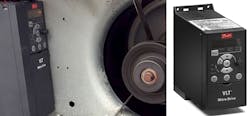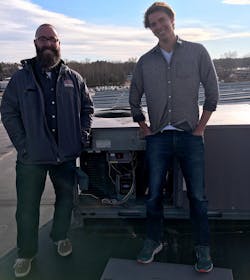Technology Drives Efficiency for Vermont Rooftop Units
Known as the “Green Mountain State,” Vermont generates significant amounts of its electricity from renewable energy sources and boasts the smallest carbon footprint in the country. To make sure it stays green, Vermont’s Public Utility Commission in the year 2000 created Efficiency Vermont. The innovative program is an energy resource for all in-state rate payers with the end goal of saving energy and putting money back in their pockets.
“Efficiency Vermont is the nation’s first energy-efficiency utility,” says Ethan Bellavance, energy consultant and engineer for the program. “We put negative kilowatts on the market just as an energy generator would offer positive kilowatts. It’s just a lot cheaper to get power by cutting consumption than by buying supplemental electricity or building power plants.”
Bellavance adds that “for end-use customers, we save Vermonters money by helping them use less energy. One way we do that is by offering commercial customers incentives, guidance and technology to reduce their electricity consumption.”
The key energy-saving technology used in this case was the Danfoss VLT® Micro Drive variable frequency drive (VFD) for packaged rooftop units (RTUs).
Retrofitting VFDs into Rooftops
“There are thousands of rooftop units in Vermont,” says Bellavance. “RTUs combine heating, cooling and ventilation functions into a single unit that sits on a rooftop and is out of the way. Our small business program was looking for a way to save significant energy by applying variable frequency drives — also known as inverters — on the fan motors used inside RTUs.”
Bellavance first got acquainted with Danfoss VFDs when he was working with refrigeration equipment in grocery stores. Danfoss not only had strong experience in refrigeration, but could also apply its VLT® Micro Drive technology as a rooftop unit controller for HVAC duty.
VFDs are used for a wide range of motors, not just RTU fan motors. Danfoss was able to pre-program the VLT® Micro Drive specifically for RTU applications and offer it to contractors as the Danfoss RTU drive. Because the programming work is done upfront, the contractor simply mounts the drive inside the RTU, wires it up and enters the nameplate installation. Most mechanical contractors can do the job in about half a day.
Danfoss partnered with IEE Interstate HVAC Controls, located in Brighton MA, and worked with their HVAC controls programmer and consultant, Sean Norwood, to supply RTU drives for the two pilot locations in Vermont.
“The idea was to set up a test on the RTU of the Efficiency Vermont office building,” says Norwood. “Their RTU is a 4-ton single-stage unit with electric cooling and gas heating. Single-stage RTUs are fairly typical in small business applications, but most use constant speed fan motors. Applying a VFD is a vast improvement.”
A VFD modifies the frequency of AC current to change the speed of a motor. In this case, the motor is used to rotate the RTU’s supply-air fan. The program in the VLT® Micro Drive signals the motor to slow down or speed up depending on the call for heating and cooling. Even reducing fan motor speed slightly can produce immense energy savings. That’s because fan motors obey the physics of Affinity Fan Laws, in which reducing fan-motor speed cuts energy consumption exponentially. For example, reducing speed by 20 percent can cut power consumption up to 50 percent.
However, those are theoretical energy savings. To find out what would actually happen, the Efficiency Vermont building in Burlington was an ideal test. “Creating new innovative energy-saving programs for small businesses in our state is critical,” explains Bellavance.
In this case, the focus was boosting HVAC efficiency where an easy-to-install, cost-effective solution for small-tonnage RTUs can make a difference — solutions like the Danfoss VLT® RTU drive.
Although Danfoss VFDs are available for motors up to 1500 hp, RTUs typically employ 1 to 10 hp fan motors — a range supported by the Danfoss VLT® Micro Drive FC 51 line. The VLT® Micro Drive is a compact frequency converter that modifies the sine wave of AC current into a form known as a pulse width modulated (PWM) wave. In that form, the wave’s frequency — measured as Hertz (Hz) — can be increased or decreased to speed up or slow down motor speed.
To program the output speeds required by the application, the VLT® Micro Drive contains a programmable logic controller (PLC) and digital keypad.
“It is easy to program the VLT® Micro Drive,” explains Norwood. “The Efficiency Vermont building’s RTU handles calls for heating and cooling, as well as occupied and unoccupied modes. During unoccupied mode, the fan remains off. In occupied mode, the fan idles at low speed (about 30 Hz). In either mode, if there is a call for heating or cooling, the fan will run at high speed (about 50 Hz). Being able to program the VLT® Micro Drive to tailor fan performance to RTU operating conditions makes a big difference in energy consumption.”
The VLT® Micro Drive is also small enough to fit inside RTUs. Depending on the model, VLT® cabinet sizes range from 6- to 13-inches high, 2.75- to 6.5-inches wide, and 6- to 9.75-inches deep. Inside the cabinet, printed circuit boards are well protected with a specialized coating applied over the electronics to ensure reliability. Highly efficient internal air circulation permits installation in ambient temperatures up to 122°F (50°C).
The compact size and robust design of the Danfoss VLT® RTU Drive makes it easy to work with for every contractor. Moreover, it does not employ proprietary technology that only one or two contractors are qualified to use.
Partnership Yields Production, Payback
The Danfoss RTU Drive solution is specifically designed for the small business market. It offers a pre-programmed drive with a control sequence for light commercial RTUs, while maintaining comfort.
For the 2017 test on the Efficiency Vermont building, Danfoss and Interstate HVAC Controls assisted with installation so Bellavance could collect detailed data on single-stage supply fan motor energy usage.
The results were impressive – even when the RTU was running at full cooling during a hot day, the fan motor ran at about 50 Hz as opposed to the usual 60 Hz. That reduced electricity demand by 27 percent. Compared to the baseline fan motor, energy savings were 57 percent.
Meanwhile, occupants in the Efficiency Vermont building remained comfortable. Heating and cooling operations met the prescribed set points, and ventilation operated normally. The only difference is a significantly lower electric bill and improved humidity control.
End-use customers with similar RTUs are seeing paybacks under two years when combined with rebate incentives from Efficiency Vermont. In other cases, the payback ranges from under one to less than three years, depending on the configuration.
Because electricity demand is reduced, utilities also benefit. In 2017, Efficiency Vermont’s VFD program cut electricity consumption by about 3,000 megawatt hours.
Since 2016, the RTU program has grown 200 percent — spurred by more than 40 energy consultants from Efficiency Vermont and contractors in their Efficiency Excellence Network talking to business people all over the state.
“Danfoss helped us turn what would have been a difficult custom VFD application into an off-the-shelf solution any contractor can work with,” says Norwood. “This solution gives contractors the flexibility to support more complex RTU configurations their customers may have. And Danfoss RTU Drives let utilities offer small businesses a green HVAC solution that saves energy and cuts business operating costs at the same time.”




